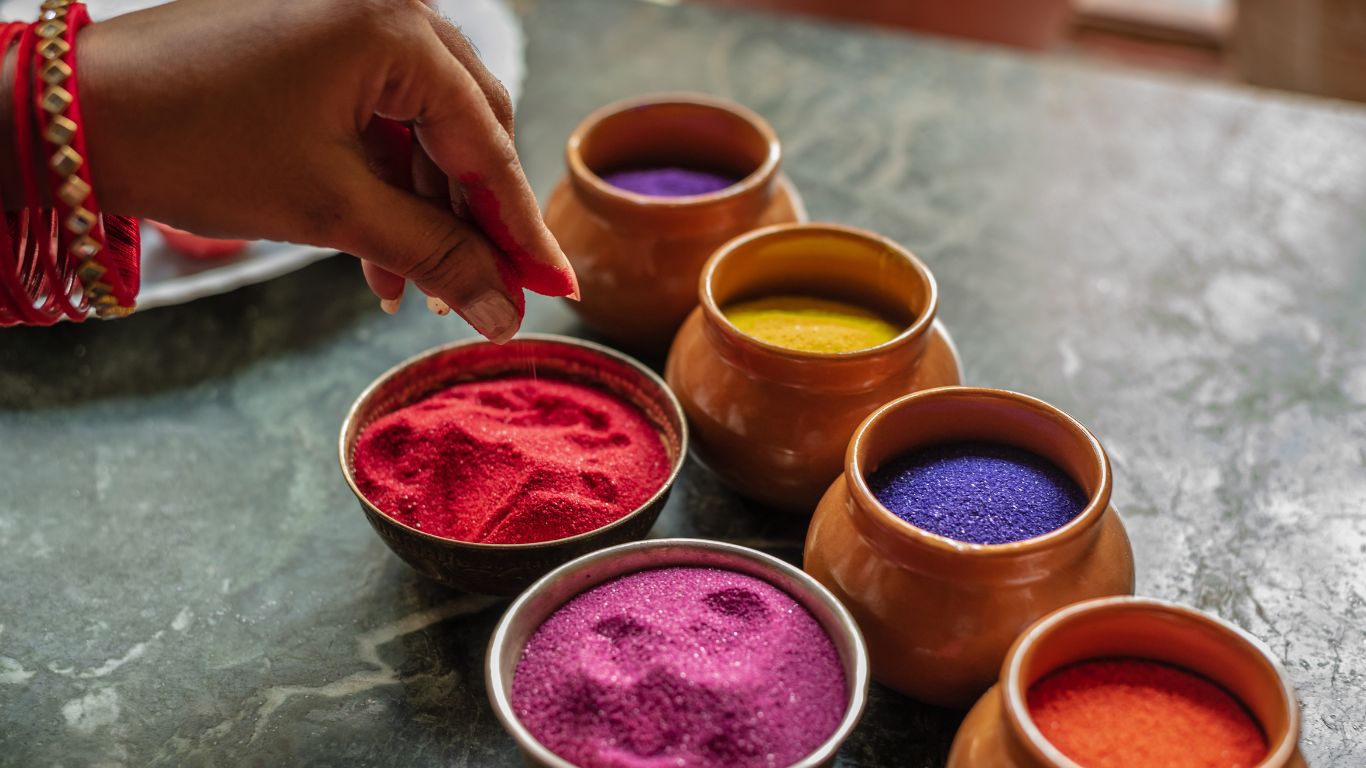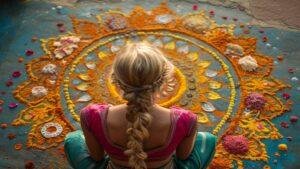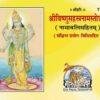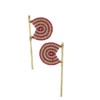Rangolis come in a variety of forms and are drawn in many ways. Rangoli are scientifically explained by their ability to elicit a wide range of spiritual experiences. There is a scientific explanation and a spiritual significance for every variety of Rangoli. Begin your rangoli-making adventure with confidence! Dive into our collection of effortless designs and let your creativity flow.
The Rangoli’s Spiritual Significance
- It is well known that drawing shapes in Southern India and Tamil Nadu tends to enhance the Bhav sense of spirituality.
- Before pujas and worship begin, lotuses are drawn. These forms are renowned for their Chaitanya, or energy-evoking, properties.
- The square and symmetrical patterns have been shown to have energies that give people bliss, or Ananda.
- Rangoli’s fundamental idea is known as the Divinity concept.
Indian Customs Surrounding Rangoli

In South India, rangolis are often referred to as Kolam. India is renowned for its remarkable customs, many of which include secrets that help to fortify social and cultural ties. They are primarily recognized as the domain of women.
In the past, women would get up early to clean the outside of their homes with water before daylight. There are villages and isolated locations where people scatter cow dung-infused water. When the water has dried, they begin to create exquisite designs that are flawlessly connected with no breaks or gaps.
The Science Underlying Rangoli
- The usual materials used to draw rangolis are rice flour or rice powder. They provide food for birds and insects. The lesson that follows is that we ought to be kind to other living things.
- Women rise early before morning to complete their labor of drawing Kolams. They are intelligent and healthy since they have the habit of rising before dawn.
- Hindu scriptures have always provided ample evidence of the excellence of women in creating and raising their families and offspring. Early morning Kolam drawing is a great approach to strengthening a woman’s body and soul.
- It is important to take caution when drawing Kolams so as not to highlight any breaks or distorted features in the patterns. Most women would never tolerate a distorted shape for a rangoli and would never consider starting over by cleaning the entire space. This is because any fractures or warped shapes draw in malevolent energy from the surroundings.
- Gods and good energy can be called upon through forms that are symmetrical and positive. As a result, much attention is paid to ensuring that the Kolam is drawn with perfect symmetry and without any gaps. This caution is exercised for the same reason even when filling in the colors.
- Except for their fingers, ladies only use their fingers to draw Kolams and fill in colors. This Mudra method increases women’s spiritual endurance.
Rangoli in Society and Culture
At festivals and extraordinary events, women typically work in pairs to draw larger Kolams. This makes their relationship stronger. They also make a significant effort in choosing the pattern and colors, and they strive to outdo the other ladies in the neighborhood with their best rangoli. This is a constructive approach to instill sportiness and fortify the cultural ties that bind women together.
Kolams are much more than merely artwork in many Indian families. Every family will have its own designs that are handed down through the years. Some families never divulge the techniques they use to draw such complex designs effortlessly and flawlessly. They only divulge the secrets to their daughters and daughters-in-law, who are their social successors, because they view it as a source of cultural pride.
What is the origin of the name Rangoli?

The Sanskrit word Rangavalli is where the name Rangoli first appeared. Rangavalli is the Sanskrit word for colorful creepers. As a result, this rangavalli gradually gave way to the phrase that is currently widely used.
What Names are given to Rangoli in Various Indian States?
In different Indian states, rangoli is referred to by different names, but having the same origin and practice.
- Andhra Pradesh – Muggu
- Bihar – Aripana
- Chhattisgarh – Chauk Purna
- Gujarat – Sathiya
- West Bengal – Alpana
- Karnataka – Rangavali
- Kumaon region of Himalayas – Aipan or Alokathap
- Tamilnadu – Kolam
- Rajasthan – Mandana
- Odisha – Osa
- Kerala – Poovidal or Kolam
Steps to draw
1. Draft the outline
- To create the fundamental framework of your design, begin with the central dot and draw lines or curves to link the dots.
- Geometric patterns like squares and triangles or more complex floral designs are common patterns.
- Verify that the lines are clean and symmetrical.

2. Provide Information
- Add little embellishments inside the shapes after the basic outline is finished.
- Petals, leaves, and other complex designs can be made.


3. Stuff with Colors
- Apply colored powders to the outlined shapes with caution.
- For exact placement, use your fingers or a small spoon.
- To prevent smudging, work your way toward darker hues starting with lighter ones.

4. Improve the Layout
- Incorporate smaller features such as dots, thin lines, or extra patterns using contrasting hues.
- For finer lines, you can use instruments like a toothpick or a small stick.
5. Last Words
- Make sure the rangoli is completely colored and devoid of any white space.
- For a crisp, clean finish, remove any loose powder from the design’s surroundings.
Which Place is Best for Drawing Rangoli?
Primarily, they are depicted on surfaces that greet guests as they enter the house, including porches and entryways. Vastu also dictates that they be drawn in the main area of the house and in the backyards of Tulasi Kota. On the platforms in the kitchen and puja rooms, people also draw Muggulu or Kolams. According to Vastu, they can be drawn anyplace to attract good vibes and optimism.
When is Rangoli’s Drawing, not done?
When they are in sorrow, Indians do not draw them in their homes. Because of this, it is said that a house without rangoli on regular days is unlucky and represents ill luck.
Conclusion
In summary, Rangoli is a representation of the joyous celebrations in India and much more than merely a decorative art form. It is a treasured tradition that keeps thriving and changing because of its symbolism, spiritual significance, and cultural legacy. Rangoli can enthrall and inspire people from all social classes, whether it is due to its vivid colors, complex patterns, or the uplifting spirit it produces.



















Add comment